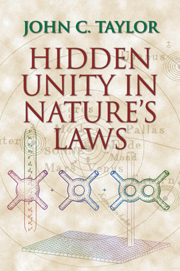Book contents
- Frontmatter
- Contents
- Preface
- 1 Motion on Earth and in the Heavens
- 2 Energy, Heat and Chance
- 3 Electricity and Magnetism
- 4 Light
- 5 Space and Time
- 6 Least Action
- 7 Gravitation and Curved Spacetime
- 8 The Quantum Revolution
- 9 Quantum Theory with Special Relativity
- 10 Order Breaks Symmetry
- 11 Quarks and What Holds Them Together
- 12 Unifying Weak Forces with QED
- 13 Gravitation Plus Quantum Theory – Stars and Black Holes
- 14 Particles, Symmetries and the Universe
- 15 Queries
- APPENDIX A The Inverse-Square Law
- APPENDIX B Vectors and Complex Numbers
- APPENDIX C Brownian Motion
- APPENDIX D Units
- Glossary
- Bibliography
- Index
10 - Order Breaks Symmetry
Published online by Cambridge University Press: 20 January 2010
- Frontmatter
- Contents
- Preface
- 1 Motion on Earth and in the Heavens
- 2 Energy, Heat and Chance
- 3 Electricity and Magnetism
- 4 Light
- 5 Space and Time
- 6 Least Action
- 7 Gravitation and Curved Spacetime
- 8 The Quantum Revolution
- 9 Quantum Theory with Special Relativity
- 10 Order Breaks Symmetry
- 11 Quarks and What Holds Them Together
- 12 Unifying Weak Forces with QED
- 13 Gravitation Plus Quantum Theory – Stars and Black Holes
- 14 Particles, Symmetries and the Universe
- 15 Queries
- APPENDIX A The Inverse-Square Law
- APPENDIX B Vectors and Complex Numbers
- APPENDIX C Brownian Motion
- APPENDIX D Units
- Glossary
- Bibliography
- Index
Summary
How solids and liquids change from disordered to ordered states on being cooled.
Cooling and Freezing
We are always ignorant about the detailed microscopic state of a macroscopic lump of matter. What we know about it is generally of a statistical nature. Statements about its temperature, pressure, magnetism and so on, are statements about average properties. The entropy is defined as a measure of our ignorance. All this was explained in Chapter 2.
There is one exception. If we could get the lump of matter to the absolute zero of temperature, it would (in principle) be in a single quantum state: the state of minimum energy. The entropy (as well as the temperature) would be zero. This would be very interesting, because we would be studying the quantum theory of macroscopic things, not just of atoms. It is very difficult to get near enough to the absolute zero of temperature to achieve this single quantum state. But fortunately nature does provide us with many examples of interesting large-scale quantum effects that occur when bodies are made cold enough. Some of these have always been familiar; others were total surprises when they were discovered in the twentieth century.
When water is cooled, ice crystals form. This happens at a welldefined temperature (for a given pressure). There is a qualitative difference between water and ice. In a crystal, the molecules are arranged in a regular array, held in place by the forces between them. Knowledge about the positions of molecules at one point tells us something about their positions at macroscopic distances away (say, millimetres).
- Type
- Chapter
- Information
- Hidden Unity in Nature's Laws , pp. 290 - 308Publisher: Cambridge University PressPrint publication year: 2001



